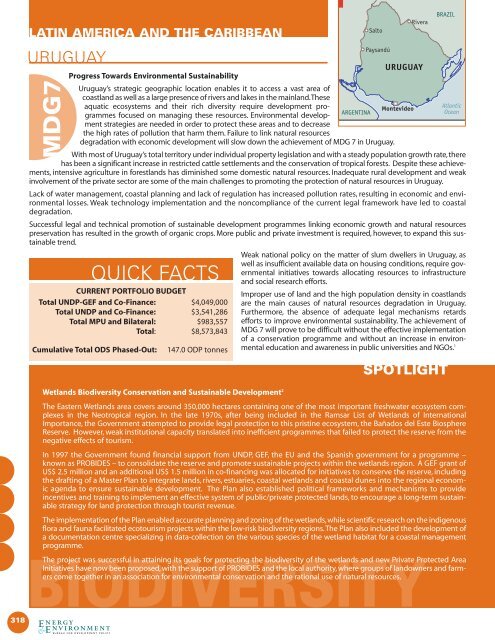ENG - UN CC:Learn
ENG - UN CC:Learn
ENG - UN CC:Learn
Create successful ePaper yourself
Turn your PDF publications into a flip-book with our unique Google optimized e-Paper software.
LATIN AMERICA AND THE CARIBBEAN<br />
URUGUAY<br />
MDG7<br />
Progress Towards Environmental Sustainability<br />
Paysandú<br />
Uruguay’s strategic geographic location enables it to access a vast area of<br />
coastland as well as a large presence of rivers and lakes in the mainland.These<br />
aquatic ecosystems and their rich diversity require development programmes<br />
focused on managing these resources. Environmental develop-<br />
ARGENTINA<br />
ment strategies are needed in order to protect these areas and to decrease<br />
the high rates of pollution that harm them. Failure to link natural resources<br />
degradation with economic development will slow down the achievement of MDG 7 in Uruguay.<br />
With most of Uruguay’s total territory under individual property legislation and with a steady population growth rate, there<br />
has been a significant increase in restricted cattle settlements and the conservation of tropical forests. Despite these achievements,<br />
intensive agriculture in forestlands has diminished some domestic natural resources. Inadequate rural development and weak<br />
involvement of the private sector are some of the main challenges to promoting the protection of natural resources in Uruguay.<br />
Lack of water management, coastal planning and lack of regulation has increased pollution rates, resulting in economic and environmental<br />
losses. Weak technology implementation and the noncompliance of the current legal framework have led to coastal<br />
degradation.<br />
Successful legal and technical promotion of sustainable development programmes linking economic growth and natural resources<br />
preservation has resulted in the growth of organic crops. More public and private investment is required, however, to expand this sustainable<br />
trend.<br />
QUICK FACTS<br />
CURRENT PORTFOLIO BUDGET<br />
Total <strong>UN</strong>DP-GEF and Co-Finance: $4,049,000<br />
Total <strong>UN</strong>DP and Co-Finance: $3,541,286<br />
Total MPU and Bilateral: $983,557<br />
Total: $8,573,843<br />
Cumulative Total ODS Phased-Out:<br />
147.0 ODP tonnes<br />
Wetlands Biodiversity Conservation and Sustainable Development 2<br />
Weak national policy on the matter of slum dwellers in Uruguay, as<br />
well as insufficient available data on housing conditions, require governmental<br />
initiatives towards allocating resources to infrastructure<br />
and social research efforts.<br />
Improper use of land and the high population density in coastlands<br />
are the main causes of natural resources degradation in Uruguay.<br />
Furthermore, the absence of adequate legal mechanisms retards<br />
efforts to improve environmental sustainability. The achievement of<br />
MDG 7 will prove to be difficult without the effective implementation<br />
of a conservation programme and without an increase in environmental<br />
education and awareness in public universities and NGOs. 1<br />
BIODIVERSITY<br />
The project was successful in attaining its goals for protecting the biodiversity of the wetlands and new Private Protected Area<br />
Initiatives have now been proposed, with the support of PROBIDES and the local authority, where groups of landowners and farmers<br />
come together in an association for environmental conservation and the rational use of natural resources.<br />
Salto<br />
Rivera<br />
URUGUAY<br />
Montevideo<br />
BRAZIL<br />
SPOTLIGHT<br />
The Eastern Wetlands area covers around 350,000 hectares containing one of the most important freshwater ecosystem complexes<br />
in the Neotropical region. In the late 1970s, after being included in the Ramsar List of Wetlands of International<br />
Importance, the Government attempted to provide legal protection to this pristine ecosystem, the Bañados del Este Biosphere<br />
Reserve. However, weak institutional capacity translated into inefficient programmes that failed to protect the reserve from the<br />
negative effects of tourism.<br />
In 1997 the Government found financial support from <strong>UN</strong>DP, GEF, the EU and the Spanish government for a programme –<br />
known as PROBIDES – to consolidate the reserve and promote sustainable projects within the wetlands region. A GEF grant of<br />
US$ 2.5 million and an additional US$ 1.5 million in co-financing was allocated for initiatives to conserve the reserve, including<br />
the drafting of a Master Plan to integrate lands, rivers, estuaries, coastal wetlands and coastal dunes into the regional economic<br />
agenda to ensure sustainable development. The Plan also established political frameworks and mechanisms to provide<br />
incentives and training to implement an effective system of public/private protected lands, to encourage a long-term sustainable<br />
strategy for land protection through tourist revenue.<br />
The implementation of the Plan enabled accurate planning and zoning of the wetlands,while scientific research on the indigenous<br />
flora and fauna facilitated ecotourism projects within the low-risk biodiversity regions.The Plan also included the development of<br />
a documentation centre specializing in data-collection on the various species of the wetland habitat for a coastal management<br />
programme.<br />
Atlantic<br />
Ocean<br />
318

















